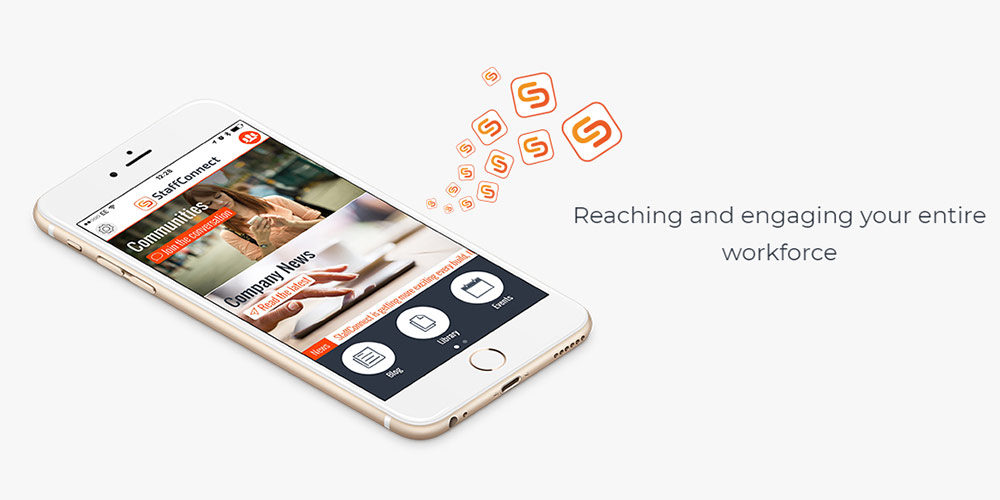Aon Hewitt, Gallup, Kronos, Deloitte, and other world leading authorities have provided overwhelming substantiation of the exploding employee engagement crisis. Consequently, the issue is climbing to the very top of most HR professional’s priority lists. Likewise, the C-suite is paying close attention as well due to the undeniable effect employee engagement has on profitability and shareholder value.
Today, we speak with Geraldine Osman, Vice President of Marketing for StaffConnect, and a respected voice on this important subject.

Q: The most highly respected authorities on business, employee engagement and like topics have all published and spoken on the crisis that is being faced; and their admiration for forward looking companies that have recognized it and are moving to act. Likewise, they are concerned that others are missing the boat and will face the very dire consequences. Could you share your perspective?
A: Employee engagement has been on the radar for some time, as more and more organizations have been recognizing its critical importance to customer satisfaction and the bottom-line. However, as the world’s workforce had evolved over the last decade, so has employee expectations – i.e., what employees want and expect from their employers. Pay, hours and benefits are no longer the only primary concerns. Career path, workplace conditions, brand reputation, and recognition for a job well-done, as well as communication (top-down, top-up and cross departmental) have risen to the top of the employee expectations list. And, organizations that are not recognizing these critical employee necessities, not recognizing the value of their employees, are feeling the pain. After all, in this digital economy another job opportunity is just a click away. Sites like LinkedIn have made it very easy to find and secure the next employment opportunity from the comfort of your living room.
Ultimately attrition is not always the worst outcome, disengaged employees that remain in the workforce have a disruptive and damaging effect on the organizations they work for. Do the math, disgruntled employees are typically not giving their best effort, not achieving optimum results, not providing the best customer service – this drives down productivity, negatively effects bottom-line results and shareholder value.
Dissatisfied customers, lost good-will, damage to brand reputation and lost revenue are not the only potential consequences keeping HR and the C-suite up at night. The Bureau of National Affairs reports that $11 billion is lost each year due to employee turnover. Experts agree, the cost of losing an employee can cost 1.5 – 2x the employee’s annual salary. These costs include hiring, on-boarding, training, ramp time to peak productivity, etc… In the meantime, other employees are impacted by having to pick up additional workload, and they become at risk of becoming disengaged themselves. An unfortunate and all too common domino effect.
Additionally, social media and ranking sites have made it all too easy for anyone to express their opinion about their employer to a far wider audience than ever before, regardless of truth or accuracy, which in turn can also impact the organizations ability to attract new talent.
 Recommended: OSNEXUS QuantaStor SDS Platform Makes It Easy For IT Professionals To Manage And Secure Storage Appliances
Recommended: OSNEXUS QuantaStor SDS Platform Makes It Easy For IT Professionals To Manage And Secure Storage Appliances
Q: Would you put forward that non-desk employees – those working the floor, may feel even further removed?
A: Absolutely. Non-desk employees – or frontline employees, those that are not sitting at their desk, in the building with easy access to onsite meetings, hallway conversations and a corporate intranet – those that are out in the field and on-the-road are often regarded as the “forgotten workforce.” These employees are underserved by technology and can feel even further removed and disconnected from corporate goals and the core purpose of the business they are part of. It is no coincidence that, employee engagement statistics among this large and growing populace are even more dismal. This is very concerning, given that today non-desk employees make up over 80% of the world’s workforce, and in todays gig economy, the non-desk employee number is only expected to rise.
Q: Who is feeling the pain most acutely?
A: While the employee engagement crisis affects all industries regardless of geography or vertical, there are particular markets which by definition have larger proportions of non desk or frontline employees. For instance, Gallup recently released an article highlighting that manufacturing has much lower levels of engagement. Its certainly no coincidence that manufacturing is also heavily made up of non-desk workers. Similarly, healthcare, hospitality, retail, travel, logistics, construction – all characteristically have high proportions of field-based, distributed workforces.
Certainly, today’s increasingly expanding gig economy – short-term contracts or freelance work (think Uber, DoorDash, Deliveroo, etc.) are also prime candidates for disengagement. Maintaining the required information flow and keeping these workers connected and feeling part of the organziation is a struggle for these emerging businesses.
The issue is not limited to for profit companies, nonprofits face their own unique yet highly critical employee engagement challenges as well, with blended, distributed workforces comprised of paid staff and volunteers which typically tend to be very field-driven. The non profit relies on referral and a strong reputation to be able to attract and retain the volunteers that are essential to their success.
 Recommended: Next Caller Raises $5M Series A Funding To Help Its Clients Increase Sales Conversion
Recommended: Next Caller Raises $5M Series A Funding To Help Its Clients Increase Sales Conversion
Q: So, what advice would you offer those that are seeking to proactive address the employee engagement crisis?
A: The best way to address the employee engagement crisis is to see technology as an enabler, but not the total solution. Technology must be combined with strategy and measurement. This is how we have designed the StaffConnect solution. There is a user app, which is mobile, easy to use, intuitive – it reaches the entire workforce – wherever they are and whatever they do. StaffConnect is designed to engage – and that means employees have a voice and are able to share views, opinions, and content to feel truly part of the organization.
We also believe that to be successful you have to have a strategy – which is why we have a team of domain experts that work closely with our customers to define winning content and communication strategies that go hand-in-hand with the technology to achieve specific measurable goals.
And finally we deliver analytical capability to measure engagement and see on an ongoing basis which content and communications are being successful in which regions or functions. This enables a granular understanding of engagement in the workforce and gives our customers the ability to pinpoint where engagement is lower or higher and adjust their strategy accordingly.
The most proactive and successful in addressing the employee engagement crisis are typically today’s most well-known and highly respected brands. These organizations, regardless of geography or industry, have bigger workforces – and the bigger the workforce, the bigger the problem. Moreover, its no surprise they are leaders in their respective businesses, these organizations are those that are usually on the cutting-edge of strategy and technology deployment – early adopters, those that stay ahead of the curve in identifying problems and finding solutions, and correspondingly reap the rewards.
Activate Social Media:


